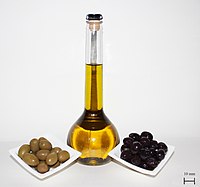
Photo from wikipedia
Abstract Sesame (Sesamum indicum L.) is an important oil seed with edible and potentially nutritional and medical uses in most countries and may show variability for bioactive concentrations. The objective… Click to show full abstract
Abstract Sesame (Sesamum indicum L.) is an important oil seed with edible and potentially nutritional and medical uses in most countries and may show variability for bioactive concentrations. The objective of this study was to evaluate seed production weights, numbers, oil, protein, lignan, tocopherol, and fatty acid concentrations in seeds from 8 randomly diverse sesame genotypes with various seed coat colors over two years. Oil analysis were conducted using NMR (nuclear magnetic resonance) on a Bruker mq-one minispec. Protein was measured by combustion on an Elementar Rapid N Exceed nitrogen analyzer. Lignan and tocopherol compounds were prepared and analyzed by HPLC (high performance liquid chromatography) on an Agilent 1100. Fatty acids were separated by gas chromatography on an Agilent 7890A with a 15 m DB23 analytical column and FID (flame ionization detector). The bioactives and 1000 seed weights were significantly influenced by genotype, except for heptadecenoic acid (17:1), while total seed weight, total seed numbers, sesamolin, γ-tocopherol, and oleic acid (18:1) were influenced by year. Oil, protein, δ-tocopherol, and margaric acid (17:0) showed a year x genotype interaction. Significant 1000 seed weights ranged from 1.8 to 3.3 g while oil and protein concentrations significantly ranged from 29.43–54.69% and 13.92–21.76%, respectively. Sesamin and sesamolin ranged significantly from 0.55 to 8.98 mg/g and tocopherols ranged from 0 to 239.58 μg/g. The major unsaturated fatty acids, oleic (18:1) and linoleic (18:2) acids significantly ranged from 26.60 to 54.85 % while the minor unsaturated fatty acids ranged from 0.13 to 0.89 %. The saturated fatty acids significantly ranged from 0 to 10.58 %. Several correlations were observed among the bioactives. The 8 sesame genotypes can be used in breeding programs to develop new cultivars with enhanced bioactives.
Journal Title: Industrial Crops and Products
Year Published: 2021
Link to full text (if available)
Share on Social Media: Sign Up to like & get
recommendations!